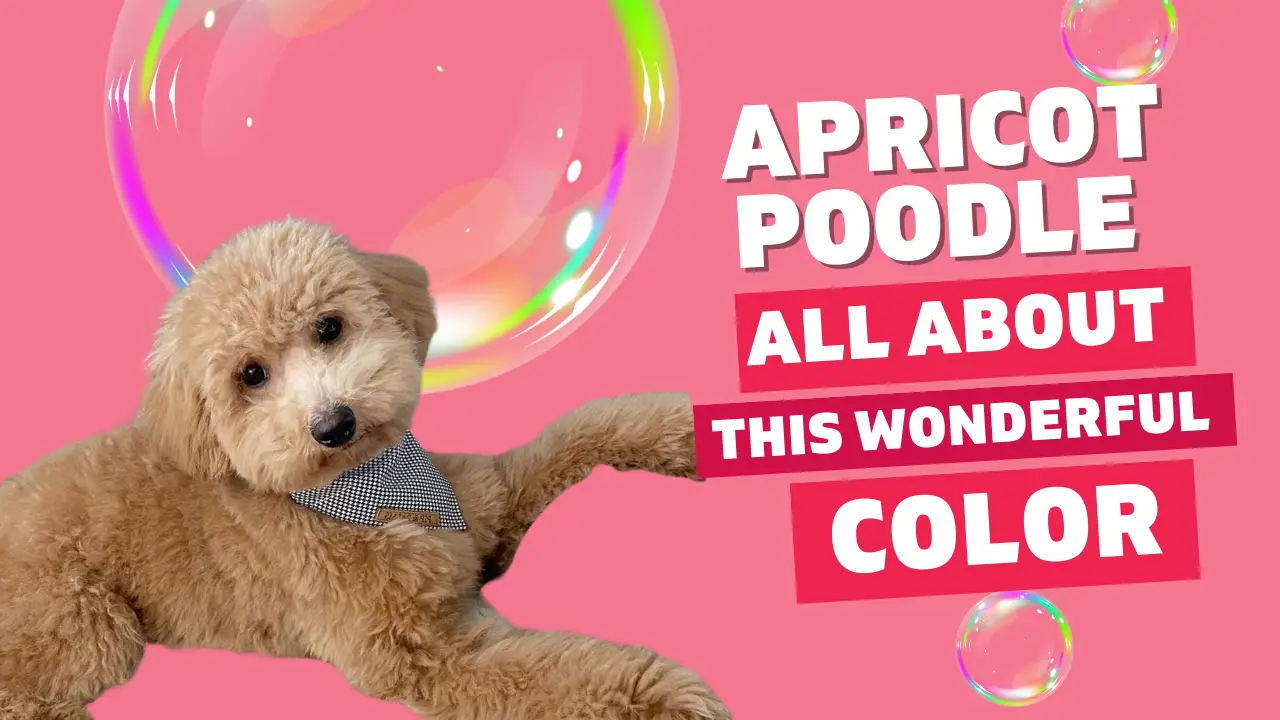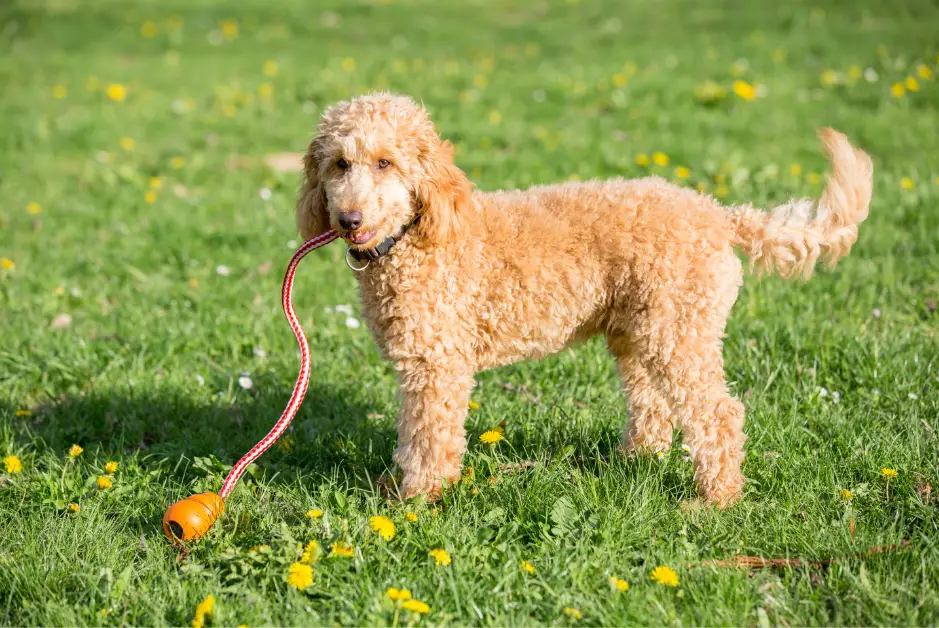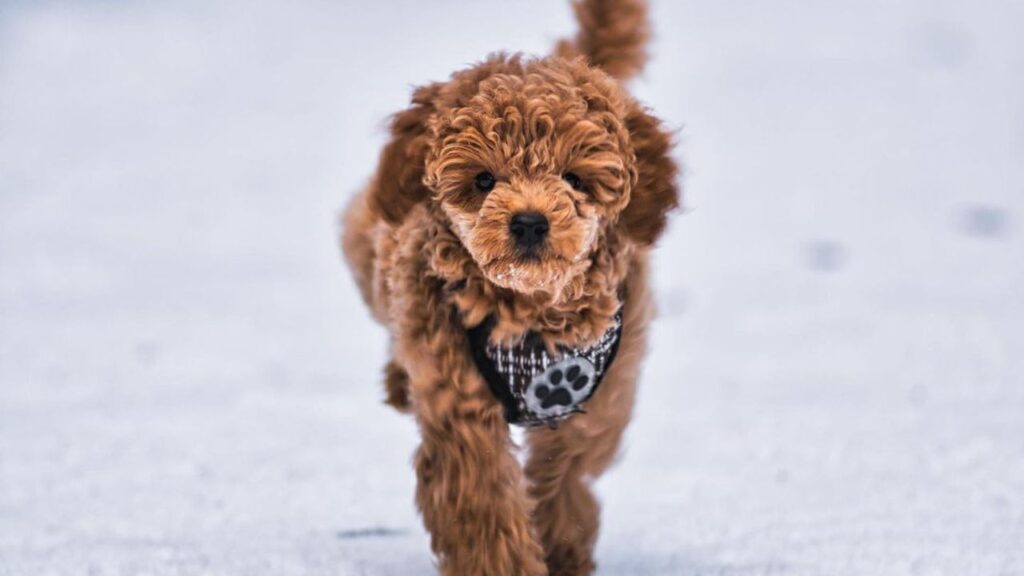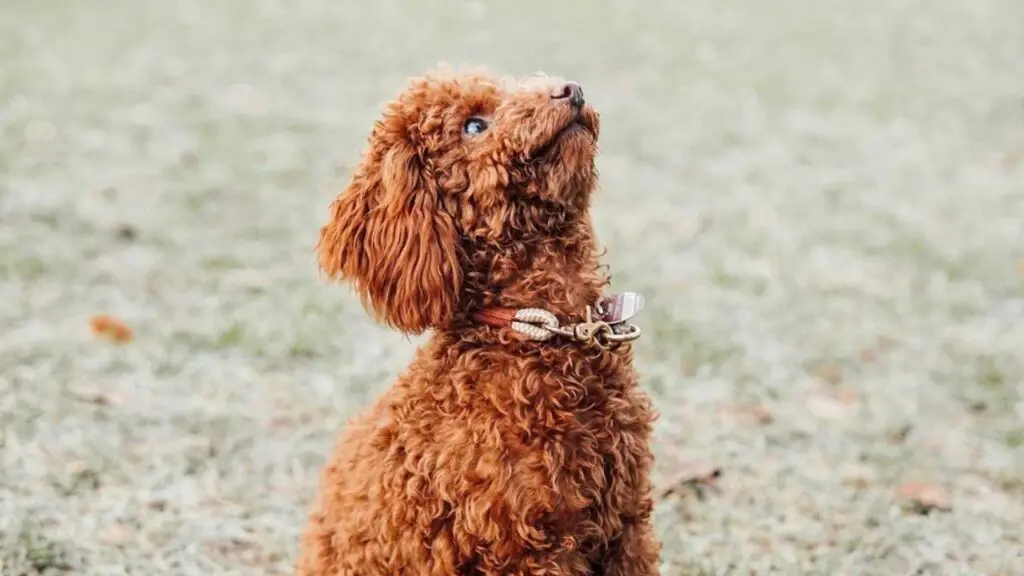If you haven’t seen this poodle in beauty pageants, you must have noticed them in pictures while browsing for poodle breeds online. These rare and beautiful creatures are distinguished from other poodle counterparts by their eye-catching apricot color. An apricot poodle is a rare sight when you are taking a stroll in the city park, or even in the breeding kennels, and that makes them even more attractive in a mysterious way.

What comes to your mind when you think of the word apricot?
Wait, let us answer that for you.

Read our Smart Poodles - Smart Tricks eBook for only $2.99
Dive into a treasure trove of engaging tricks and tips designed specifically for your poodle!
Most likely, it’s a juicy orange fruit with red tints.
Well, yes, that’s partially true. But this beautiful fruit has set the benchmark for other objects and beings showing similar colors.
Which also goes for the Apricot poodle.
While there are many stunning poodles out there, the apricot poodle is definitely at the top of the spectrum. The reason behind their name is due to the vibrant hue of their coat.
What Will You Learn? 👇
History of the Apricot Poodle

To know more about an apricot poodle’s unique qualities, we really need to jump back in time.
It’s believed that the first (recorded) apricot poodle was way back in 1898, known as Snowden Yellow Gall.
At the time, the breeder referred to Snowden as a liver color; however, she later gave birth to a litter consisting of red and brown colored poodles.
Following this, an English kennel purchased this litter and managed to maintain the breed. Allowing them to breed more standard poodles with apricot coats.
Later on, in 1912, miniature poodles were becoming incredibly popular. Around about the same time, a miniature poodle was born in Whippendall Kennel with an apricot coat.
Fast forward to 1929, in the dog world, there was a standard poodle known as Jessie who won a dog show, who was the first apricot colored poodle to do so.
Only a year later, in the 1930s, many poodle breeders in the United States imported poodles over from England to enrichen and improve the existing poodle lines. It was from here the apricot color began to spread across continents.
Unfortunately, due to WWI, poodle breeding paused due to the war but resumed after. In England, in the 1950s, there were two well sought after kennels that began to breed more apricot poodles.
More about the Apricot Poodle’s Coat
If you want to bring a poodle home or simply wish to look out for one, you will need to observe its coat. An apricot poodles coat is slightly darker than a cream-colored poodle and is more lively in color.

Do note; it can be quite hard to notice the difference between a cream poodle and an apricot one.
It’s not uncommon for many cream poodles to be classed as apricot if they have a deep coat. This also goes for red poodle puppies being classed as apricot too.
Ultimately, the color of the coat will not be consistent throughout as they have dark feathers on their ears and a ruff tipping.
Usually, as the poodle gets older, its coat may become lighter or even darker. It’s not unusual either for a puppy who had a light apricot coat to grow into a dark solid cream coat.
When going to a breeder to buy a poodle, you aren’t always guaranteed to get the poodle that matches the coat color you would like. While they may match it as a puppy, they could grow into a different coat.
Sadly, breeders are free to register a poodle to be a certain color, and often when poodles grow into adults, their coat color does not match the one on their papers.
What causes darker red hair in one spot on an apricot poodle?
It’s not uncommon to see dark spots or darker areas of red hair in a certain location of an apricot poodle. Most of the time, these are referred to as black points or liver points.
This is a recessive dark pigment that could be black or red, most likely red in an apricot on a certain area of the body. While this is normal, in countries like the United States, it’s not always viewed in a positive way. They prefer apricot poodles that don’t have areas of darker hair.
Do apricot Poodles get lighter?
We know by now that the apricot-colored poodle can be hard to detect. Just like it’s hard to identify, their coat color can change with time. Sometimes you will find dog owners discovering they have an apricot poodle when their puppy grows into an adult.
For instance, many tan or light brown poodles may fade into an apricot shade from 2 years old.
This process is known as fading. This involves a poodle’s coat undergoing a lightning process and losing its original puppy color. Sometimes these also undergo a second phase of shading from ages 2-3 and have their coat lightened even more. After this, their coat usually sustains its color.
Other features of an Apricot Poodle
But, alongside their coat, there are other features an apricot poodle is known to have, such as their nose, eyes, and chest.
- What color nose should an apricot standard poodle have?
Typically an apricot standard poodle has a similar nose to those of a brown poodle. Their nose is brown and has a leather type feature.
- What color eyes should an apricot standard poodle have?
Most poodles have dark brown colored eyes, and this is certainly the same for apricot standard poodles, which usually tend to have dark-colored eyes.
In relation to this, they also have very dark rims surrounding their eyes. Similarly, the hair underneath their eyes often has a tint of red, brown, or amber.
- What color chest should an apricot standard poodle have?
Another important feature is the chest of an apricot poodle. Usually, this poodle can have a small amount of white hair on their chest, just like red and poodles do. Can you see why they easily get mistaken for other colors?

In addition to these features, apricot poodles have dark lips and dark colored toenails too.
Are Apricot Poodles rare?
We already know by now that other breeders can easily mistake apricot poodles for other colors. Similarly, they have a lot of dark-colored features. Because they’re hard to detect and identify, does that make the apricot breed rare?
Well, it’s believed that out of all the poodle colors, the apricot color was the last one to be recorded. There are also rumors that the poodle’s dark red color sprang from the apricot color, meaning it’s one of the last noted.
It’s believed that this color is made up of different concentrations of shades of brown, blue, and white. Similarly, an apricot poodle has a recessive gene to every single color apart from white.
How big do apricot Poodles get?
If you’re looking for an apricot poodle that comes in a specific size, then you won’t be able to find them. As they are a type of coat color, you will only be able to find them in the three main types of the poodle breed standard, miniature, and toy. Which the sizes are as follows:
A standard poodle can reach anything from 18-24 inches (45-60cm) in height. Similarly, they can weigh between 45-68 pounds (20.4-31 kg).
A miniature poodle can grow anything from 10-15 inches (25-38cm) tall and weigh between 10-15 pounds (4.5-6.8 kg).
A toy poodle will reach no taller than 10 inches (25cm) tall and weigh between 4-6 pounds (1.8-2.7 kg).
Apricot poodle puppies
If you’re looking to buy an apricot poodle puppy, it might be a difficult task. This color is a rare one to find and can often get mistaken for red or brown poodles, which can cause the breeder to file its color incorrectly. Similarly, an apricot puppy may not show its true color until it’s an adult.
There’s no set price for an apricot poodle puppy. Depending on where you’re looking to buy and the breeder, the price may vary. In fact, it could be more expensive than the standard breeds because the color is not common.
To give you an idea, a standard poodle costs between $700-$1500, toy and a miniature poodle costs $1000-$2000.
How to get an apricot poodle – Buying or Adopting
If you’re looking to buy an apricot poodle, you should speak to a local breeder. When speaking to a breeder, you will want to enquire about its heritage, coat color, nose color, eye color, and chest color. You may want to ask if it has a liver spot, all the basic signs of an apricot poodle.
Similarly, as this is a rare color, you might want to seek out a specialized breeder who only breeds apricot and red poodles.
On the contrary, you might want to adopt an apricot poodle. This way, you will be able to adopt an apricot poodle when it’s fully faded. That way, you will be able to look at its coat and facial features to fully identify that you’re getting an apricot poodle.
Final thoughts
Apricot poodle is a rare colored poodle; it’s believed its coat was the last to be recorded for poodles. The first apricot poodle recorded was in 1898 and then were later bred in England. Because of the demand for apricots, breeders from the USA imported poodles from England to better the line.
As a result, more apricot poodles came about and now exist all over the world. Their coat has a red tint, but breeders often mistake their apricot color for others, so many apricot poodles can be registered as brown or beige.
Similarly, some apricot poodles have dark spots of brown or red in one area of their body known as a liver spot, their chest hair can become white, and they have dark facial features such as their nose and eyes.
Plus, there’s no specific size to an apricot poodle, as it’s only their coat color; you will only be able to find them in the typical sizes of the standard, miniature, or toy poodle.
Marko is the founder and author at PoodleHQ, where he blends profound expertise with formal training in Animal Behavior and Canine Genetics. With multiple generations of poodles under his care, he’s a breed connoisseur, honored with the Canine Care Excellence Award and lauded by the International Pet Enthusiasts Association.


Yes I’ve just gotten a beautiful 6 month old female apricot poodle to be my friend and hopefully an assistance dog for me. She is much admired, sweet and funny. A wee bit tall at 19 1/2 inches. That suits me at a human female 5 ft 8 inches. She’s gorgeous and I don’t care if her colour fades. The classic dark eyes, black nails etc are there. Thank you Poodle world for this darling pup and light of my life. Catherine aka Una